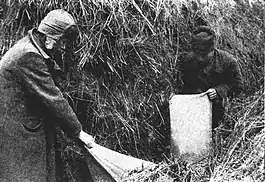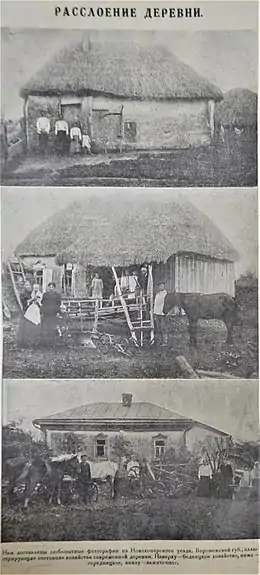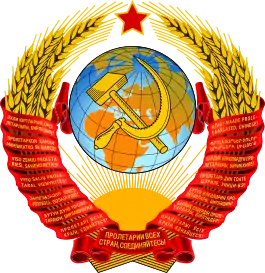Kulak
Kulak (/ˈkuːlæk/; Russian: кула́к; plural: кулаки́, kulakí, 'fist' or 'tight-fisted'), kurkul (Ukrainian: куркуль) or golchomag (Azerbaijani: qolçomaq, plural: qolçomaqlar) was the term used towards the end of the Russian Empire to describe peasants with over 8 acres (3.2 hectares) of land. In the early Soviet Union, particularly Soviet Russia and Azerbaijan, kulak became a vague reference to property ownership among peasants who were considered "hesitant" allies of the revolution.[1] In 1930–31 in Ukraine also existed a term of pidkurkulnyk (almost wealthy peasant).

| Part of a series on |
| Communism |
|---|
|
|
The word kulak originally referred to former peasants in the Russian Empire who became wealthier during the Stolypin reform from 1906 to 1914. During the Russian Revolution, the label of kulak was used to chastise peasants who withheld grain from the Bolsheviks.[2] According to Marxist–Leninist political theories of the early 20th century, the kulaks were class enemies of the poorer peasants.[3] Vladimir Lenin himself described them as "bloodsuckers, vampires, plunderers of the people and profiteers, who fatten on famine,"[4] declaring revolution against them to liberate poor peasants, farm laborers, and proletariat (the much smaller class of urban and industrial workers).[5]
During the first five-year plan, Stalin's all-out campaign to take ownership and organisation from the peasantry meant that "peasants with a couple of cows or five or six acres [~2 ha] more than their neighbors" were labeled kulaks.[6] Under dekulakization, government officials seized farms and killed some resisters,[3][7] deported others to labor camps, and drove many to migrate to the cities following the loss of their property to the collective.[8]
Definitions

Soviet terminology divided the Russian peasants into three broad categories:
- bednyak, or poor peasants;
- serednyak, or mid-income peasants; and
- kulak, the higher-income farmers who had larger farms.
In addition, they had a category of batrak, landless seasonal agricultural workers for hire.[3]
The Stolypin reform created a new class of landowners by allowing peasants to acquire plots of land on credit from the large estate owners. They were to repay the credit (a kind of mortgage loan) from their farm earnings. By 1912, 16% of peasants (up from 11% in 1903) had relatively large endowments of over 8 acres (3.2 ha) per male family member (a threshold used in statistics to distinguish between middle-class and prosperous farmers, i.e. the kulaks). At that time, an average farmer's family had 6 to 10 children. The number of such farmers amounted to 20% of the rural population, producing almost 50% of marketable grain.[9]
1917–18
Following the Russian Revolution of 1917, the Bolsheviks considered only batraks and bednyaks as true allies of the Soviets and proletariat; serednyaks were considered unreliable, "hesitating" allies; and kulaks were identified as class enemies, as they owned land (this was later expanded to include those who owned livestock). However, a middle peasant who did not hire labor and was little engaged in trade "might yet (if he had a large family) hold three cows and two horses."[10] There were other measures that indicated the kulaks as not being especially prosperous.
Both peasants and Soviet officials were often uncertain as to what constituted a 'kulak'. They often used the term to label anyone who had more property than was considered "normal," according to subjective criteria, and personal rivalries played a part in the classification of enemies. Historian Robert Conquest argues:
The land of the landlords had been spontaneously seized by the peasantry in 1917–18. A small class of richer peasants with around fifty to eighty acres [20 to 32 ha] had then been expropriated by the Bolsheviks. Thereafter a Marxist conception of class struggle led to an almost totally imaginary class categorization being inflicted in the villages, where peasants with a couple of cows or five or six acres [about 2 ha] more than their neighbors were now being labeled "kulaks," and a class war against them declared.[6]
During the summer of 1918, Moscow sent armed detachments to the villages to seize grain. Any peasant who resisted was labeled a kulak: "The Communists declared war on the rural population for two purposes: to extract food for the cities and the Red Army and to insinuate their authority into the countryside, which remained largely unaffected by the Bolshevik coup."[2] A large-scale revolt ensued, and it was during this period, in August 1918, that Lenin sent a directive:[11]
Hang (hang without fail, so the people see) no fewer than one hundred known kulaks, rich men, bloodsuckers.… Do it in such a way that for hundreds of versts [kilometers] around the people will see, tremble, know, shout: they are strangling and will strangle to death the bloodsucker kulaks.
1930s
The average value of goods confiscated from kulaks during the policy of "dekulakization" (раскулачивание) at the beginning of the 1930s was only 170–400 rubles (US$90–$210) per household.[3] During the height of collectivization in the early 1930s, people who were identified as kulaks were subjected to deportation and extrajudicial punishment. They were often murdered in local violence while others were formally executed after conviction as kulaks.[7][12][13]
In May 1929, the Sovnarkom issued a decree that formalised the notion of 'kulak household' (кулацкое хозяйство), whereby any of the following defined a kulak:[3][14]
- Use of hired labor.
- Ownership of a mill, a creamery (маслобойня, 'butter-making rig'), other processing equipment, or a complex machine with a motor.
- Systematic renting out of agricultural equipment or facilities.
- Involvement in trade, money-lending, commercial brokerage, or "other sources of non-labor income."
By the last item, any peasant who sold his surplus goods on the market could be classified as a kulak. In 1930, this list was extended to include those who were renting industrial plants, e.g. sawmills, or who rented land to other farmers. At the same time, the ispolkoms (executive committees of local Soviets) of republics, oblasts, and krais were given rights to add other criteria for defining kulaks, depending on local conditions.[3]
Dekulakization
| This article is part of a series on the |
| Politics of the Soviet Union |
|---|
 |
In July 1929, it remained official Soviet policy that the kulaks should not be terrorized and should be enlisted into the collective farms. However, Stalin disagreed:
Now we have the opportunity to carry out a resolute offensive against the kulaks, break their resistance, eliminate them as a class and replace their production with the production of kolkhozes and sovkhozes.[15]
A decree by the Central Committee on January 5, 1930 was titled "On the pace of collectivization and state assistance to collective-farm construction."[16] Andrei Suslov argues that the seizure of peasants' property led directly to the destruction of an entire social group: the peasant‐owners. The official goal of "kulak liquidation" came without precise instructions, and encouraged local leaders to take radical action. The campaign to "liquidate the kulaks as a class" constituted the main part of Stalin's social-engineering policies in the early 1930s.[17]
On 30 January 1930, the Politburo approved the dissolving of kulaks as a class. Three categories of kulaks were distinguished: the first to be sent to the Gulags; the second to be relocated to distant provinces, such as the north Urals and Kazakhstan; and the third to other areas within their province.[18]
The peasantry were required to relinquish their farm animals to government authorities. Many chose to slaughter their livestock rather than give them up to collective farms. In the first two months of 1930, peasants killed millions of cattle, horses, pigs, sheep and goats, with the meat and hides being consumed and bartered. For instance, the Soviet Party Congress reported in 1934 that 26.6 million head of cattle and 63.4 million sheep had been lost.[19] In response to the widespread slaughter, the Sovnarkom issued decrees to prosecute "the malicious slaughtering of livestock" (хищнический убой скота).[20]
Stalin ordered severe measures to end kulak resistance. In 1930, he declared:[21]
- In order to oust the 'kulaks' as a class, the resistance of this class must be smashed in open battle and it must be deprived of the productive sources of its existence and development.… That is a turn towards the policy of eliminating the kulaks as a class.
Human impact
During 1929–1933, the grain quotas were placed artificially high. Peasants would attempt to hide grain and bury it. According to historian Robert Conquest, every brigade was equipped with a long iron bar to probe the ground for grain caches[22] and peasants who did not show signs of starvation were especially suspected of hiding food.[23] Conquest states:
When the snow melted true starvation began. People had swollen faces and legs and stomachs. They could not contain their urine... And now they ate anything at all. They caught mice, rats, sparrows, ants, earthworms. They ground up bones into flour, and did the same with leather and shoe soles ...[24]
As Vasily Grossman explained, the Party activists who helped the State Political Directorate (the secret police) with arrests and deportations "were all people who knew one another well, and knew their victims, but in carrying out this task they became dazed, stupefied."[6]
They would threaten people with guns, as if they were under a spell, calling small children 'kulak bastards,' screaming 'bloodsuckers!'… They had sold themselves on the idea that so-called 'kulaks' were pariahs, untouchables, vermin. They would not sit down at a 'parasite's' table; the 'kulak' child was loathsome, the young 'kulak' girl was lower than a louse.[6]
Party activists brutalizing the starving villagers fell into cognitive dissonance, rationalizing their actions through ideology. Lev Kopelev, who later became a Soviet dissident, explained:
It was excruciating to see and hear all of this. And even worse to take part in it.… And I persuaded myself, explained to myself. I mustn't give in to debilitating pity. We were realizing historical necessity. We were performing our revolutionary duty. We were obtaining grain for the socialist fatherland. For the Five-Year Plan.[6]
Numbers executed
Stalin ordered for kulaks "to be liquidated as a class,"[25] and this was the cause of the Soviet famine of 1932–1933.[26] This famine has complicated attempts to identify the number of deaths arising from the executions of kulaks. A wide range of death tolls has been suggested, from as many as six million suggested by Aleksandr Solzhenitsyn,[27] whereas the much lower number of 700,000 deaths are estimated by Soviet sources.
According to data from Soviet archives, which were published only in 1990, 1,803,392 people were sent to labor colonies and camps in 1930 and 1931. Books based on these sources have said that 1,317,022 reached the destinations. The fate of the remaining 486,370 cannot be verified. Deportations on a smaller scale continued after 1931. The reported number of kulaks and their relatives who died in labor colonies from 1932 to 1940 was 389,521. Former kulaks and their families made up the majority of victims of the Great Purge of the late 1930s, with 669,929 arrested and 376,202 executed.[28]
See also
- Collectivization in the Soviet Union
- Earth (1930), a Ukrainian film by Alexander Dovzhenko, concerning a community of farmers and their resistance to collectivization. Earth depicts the social struggles between Kulaks and a youth who introduces a tractor to a Ukrainian village.[29]
- Enemy of the people
- Gombeen man
- Landlord
- Land tenure
- Ural-Siberian method
- Yeoman
References
- Omarov, Vahid (November 27, 2012). "Azərbaycan SSR-də 1920-1940-cı illərdə sənayeləşdirmə və zorakı kolxozlaşdırma". Retrieved June 27, 2019.
- Richard Pipes (2001). Communism: A Brief History. Random House Digital, Inc. pp. 39–. ISBN 978-0-679-64050-9. Retrieved 7 January 2013.
- Robert Conquest (1986) The Harvest of Sorrow: Soviet Collectivization and the Terror-Famine. Oxford University Press. ISBN 0-19-505180-7.
- David Rubinstein (2001). Culture, Structure and Agency: Toward a Truly Multidimensional Sociology. SAGE Publications. p. 69. ISBN 978-0-7619-1928-5.
- Comrade Workers, Forward To The Last, Decisive Fight!
- Robert Conquest (2001). Reflections on a Ravaged Century. W. W. Norton & Company. p. 94. ISBN 978-0-393-32086-2. Retrieved 3 January 2013.
- Mikhail Gorbachev. Memoirs, 769 pages. Publisher: Doubleday; 1st ed edition (September 1, 1995) ISBN 0-385-48019-9
- McCauley, Martin (1996). Stalin and Stalinism.
- Kulaks (Korkulism) at the Ukrainian Soviet Encyclopedia.
- Conquest, Harvest of Sorrow, p. 76.
- Richard Pipes (1 September 2001). Communism: A Brief History. Random House Digital, Inc. p. 40. ISBN 978-0-679-64050-9. Retrieved 7 January 2013.
- Strobe Talbott, ed., Khrushchev Remembers (2 vol., tr. 1970–74)
- Dmitri Volkogonov. Stalin: Triumph and Tragedy, 1996, ISBN 0-7615-0718-3
- "On the characteristics of kulak farms subject to the Labor Code", Sovnarkom resolution, May 21, 1929, in: Collectivization of Agriculture: Main Resolutions of the Communist Party and Soviet Government 1927–1935, Academy of Sciences of the USSR, Institute of History, Moscow, 1957, p. 163 (Russian).
- Stalin: A Biography by Robert Service, page 266
- Lynne Viola; et al., eds. (2005). "The War Against the Peasantry, 1927-1930 : The Tragedy of the Soviet Countryside". Yale University Press. Retrieved 2018-03-26 – via ProQuest Ebook Central.
- Andrei Suslov, "'Лучше перегнуть, чем недогнуть': 'Dekulakization' as a Facet of Stalin's Social Revolution (The Case of Perm Region)" Russian Review 78.3 (2019): 371-391.
- Service, page 267
- Robert Conquest (1987). The Harvest of Sorrow: Soviet Collectivization and the Terror-famine. Oxford University Press. p. 159. ISBN 978-0-19-505180-3. Retrieved 2 August 2013.
- "On measures against malicious slaughter of livestock", Central Executive Committee and Sovnarkom resolutions, January 16, 1930; November 1, 1930, in: Collectivization of Agriculture: Main Resolutions of the Communist Party and Soviet Government 1927–1935, Academy of Sciences of the USSR, Institute of History, Moscow, 1957, pp. 260, 336 (Russian).
- Stalin, Joseph. "Concerning the Policy of Eliminating the Kulaks as a Class," Krasnaya Zvezda, January 21, 1930, Collected Works, Vol. 12, p. 189
- Conquest, Harvest of Sorrow, p. 229.
- Conquest, Harvest of Sorrow, p. 230.
- Conquest, Harvest of Sorrow, p. 244.
- Footnote on page 88 of book by Solzhenitsyn, Aleksandr (2005). H.T. Willetts, tr. One Day in the Life of Ivan Denisovich. Farrar, Straus and Giroux.
- Roman Serbyn, "The Ukrainian Famine of 1932-1933 as Genocide in the Light of the UN Convention of 1948." The Ukrainian Quarterly 62.2 (2006): 186-204.
- Solzhenitsyn, Aleksandr Isaevich, and Edward E. Ericson. "Chapter 2: The Peasant Plague." The Gulag Archipelago, 1918–1956: An Experiment in Literary Investigation. New York: HarperPerennial, 2007.
- Orlando Figes. The Whisperers: Private Life in Stalin's Russia, Metropolitan Books, 2007, p. 240. ISBN 0805074619
- Perez, Gilberto (Summer 2011). "Dovzhenko: Folk Tale and Revolution". Film Quarterly. 64 (4): 17–21. doi:10.1525/FQ.2011.64.4.17 – via Performing Arts Periodicals Database.
Further reading
- Conquest, Robert. 1987. The Harvest of Sorrow: Soviet Collectivization and the Terror-Famine.
- Douglas, Tottle. 1987. Fraud, Famine And Fascism: The Ukrainian Genocide Myth from Hitler to Harvard.
- Figes, Orlando. 2007. The whisperers: private life in Stalin's Russia. Macmillan.. detailed histories of actual Kulak families. online free to borrow
- Kaznelson, Michael. 2007. "Remembering the Soviet State: Kulak children and dekulakisation." Europe-Asia Studies 59(7):1163–77.
- Lewin, Moshe. 1966. "Who was the Soviet kulak?." Europe‐Asia Studies 18(2):189–212.
- Viola, Lynne. 1986. "The Campaign to Eliminate the Kulak as a Class, Winter 1929–1930: A Reevaluation of the Legislation." Slavic Review 45(3):503–24.
- —— 2000. "The Peasants’ Kulak: Social Identities and Moral Economy in the Soviet Countryside in the 1920s." Canadian Slavonic Papers 42(4):431–60.
- Vossler, Ron, narrator. 2006. "We'll Meet Again in Heaven." US: Prairie Public and Roadshow Productions.
- "This thirty-minute documentary is a searing chronicle of a forgotten genocide and a lost people, whose '... misery screams to the heavens.' The lost people are the ethnic German minority living in Soviet Ukraine, who wrote their American relatives about the starvation, forced labor, and execution that were almost daily fare in Soviet Ukraine during this period, 1928‑1938...major funding by the Germans from Russia Heritage Collection, North Dakota State University Libraries, Fargo, North Dakota."
External links
| Look up kulak in Wiktionary, the free dictionary. |